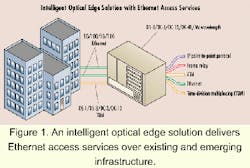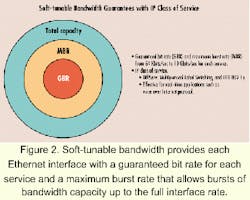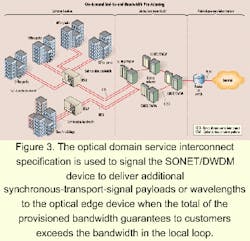Service activation at the new intelligent optical edge
ANAND PARIKH, Appian Communications
Today's Internet economy compels companies to maximize their wide-area-network (WAN) access resources, not only to maintain competitiveness, but also as a critical aspect of their growth. Yet, many companies are finding that the existing local-loop infrastructure makes it too expensive and cumbersome to obtain the right amount of bandwidth.
Within the local loop, legacy technologies developed decades ago for voice traffic are proving too expensive and too rigid to serve fast-growing Internet-protocol (IP) service requirements. Time-division multiplexing (TDM) local loops are a major reason why it takes service providers many months, multiple truck rolls, and often equipment upgrades to activate IP data services. Service providers must develop an access architecture that optimizes local loops for IP data services, while preserving their investment in existing infrastructure as well as their revenues from legacy services.
A new class of intelligent optical edge equipment allows service providers to transform TDM local loops into packet-switched local loops that feed directly into the new optical core. These devices marry IP data-switching technologies such as Ethernet with optical transport technologies such as Synchronous Optical Network (SONET) and dense wavelength-division multiplexing (DWDM).
This IP access solution allows service providers to slash service activation times from months to minutes, virtually eliminates truck rolls and equipment upgrades, and increases underlying network survivability and bandwidth scalability while riding the steep downward cost curves of high-volume Ethernet technologies.
Ten years ago, the most expensive part of WAN data service delivery was long-haul bandwidth. Today, with the rapid deployment of repeaterless long-haul DWDM solutions, the cost of carrying bits coast to coast has dwindled more than 10-fold. Yet, even as the cost of long-haul bandwidth has dropped, the cost of moving data traffic across the local loop-from the business user to the service provider's central office-remains high and the bandwidth relatively low. That is true despite the bandwidth available on today's optical local loops, because the local-loop infrastructure is still based on TDM technology that was designed 20 years ago to carry voice traffic, not data.TDM follows a rigid bandwidth hierarchy of DS-1 (1.5 Mbits/sec), DS-3 (45 Mbits/sec), OC-3 (155 Mbits/sec), OC-12 (622 Mbits/sec), and OC-48 (2.5 Gbits/sec). The jump from one level to the next does not match enterprise data requirements, which increase linearly with growing numbers of employees and applications. Inverse multiplexing does allow a small number of DS-1s to be combined for sub DS-3 applications. But customers who need bandwidth at a rate somewhere in between the TDM increments must purchase network access at the next higher quantum step, which is often significantly more than what's really needed. A customer who needs 10 Mbits/sec of WAN bandwidth is forced to purchase a 45-Mbit/sec DS-3 access link. For 55 Mbits/sec of bandwidth, a customer must pay for a 155-Mbit/sec OC-3.
This bandwidth disparity is made worse by the hands-on provisioning that TDM network access entails. Over the course of several months, a rapidly growing young company may need to upgrade its Internet access from a DS-1 to two DS-1s as employees are hired.In a typical multitenant office-park scenario, the local-exchange carrier (LEC) already has fiber terminating in a SONET multiplexer inside the building. From the add/drop multiplexer, the DS-1 is connected to the Internet service provider's (ISP's) router located in the customer's wiring closet. Despite the lit fiber and hardware already deployed, it can take the LEC and ISP more than three months to deliver the second DS-1.
First, the LEC must send field personnel to provision the new circuit on the SONET multiplexer and pull the physical wire to the customer's wiring closet. Then, the ISP must send field personnel to upgrade the router to handle inverse multiplexing of two DS-1s. Thus, the addition of a single DS-1 requires an equipment upgrade and multiple truck rolls, which can cost the service provider anywhere from $500 to $1,000 each, depending on the location.
This example raises several questions that service providers typically face in their efforts to satisfy ever-increasing demand for WAN access bandwidth. How can providers shrink service activation time and eliminate the truck rolls and equipment upgrades that today's access infrastructures require? Moreover, how can service providers contain the escalating lifecycle costs of services and make services easier to upgrade, deliver, and manage?
The solution is to use the intelligent optical edge to transform TDM-based local loops into a packet-switched access infrastructure.
The intelligent optical edge combines the best features of Ethernet switching and SONET/DWDM optical-transmission tech nology. Instead of using traditional TDM interfaces to deliver data services from SONET/DWDM networks, the intelligent optical edge uses Ethernet as a universal service interface.
All services to the business customer can be delivered using an Ethernet interface from existing IP, frame relay, and Asynchronous Transfer Mode (ATM) networks (see Figure 1). An intelligent optical edge supports protocol mediation between IP-over-Ethernet on the customer side and IP over point-to-point protocol (PPP), frame relay, and ATM on the WAN side.
Ethernet switching technology provides better bandwidth efficiency than TDM, plus the intelligence needed for on-demand service activation. Moreover, Ethernet technology has experienced the fastest cost decline and the steepest performance increase of any data-networking technology. Ethernet is ubiquitous in corporate local area networks (LANs), is easy to manage, and requires little to no new training for experienced information technology (IT) staff to implement as a WAN interface.
Large corporations are already migrating from switched 100-Mbit/sec Ethernet LAN backbones to 1-Gbit/sec Ethernet backbones. The 10-Gbit/sec Ethernet standard is being defined in the Institute of Electrical and Electronics Engineers (IEEE) 802.3 committee now, and implementations are expected by early next year. Since 10 Gbits/sec is very close to the current data rate of the OC-192 SONET interface, the disparity between LAN and WAN bandwidth may finally disappear for the first time in data-communications history.
Simply marrying Ethernet switching directly with the optical-transmission infrastructure is not enough to replace the TDM local loop. Several other requirements must be met before new intelligent access solutions can be widely deployed in service-provider infrastructures.
First, the optical access platform must deliver new services without forcing the service provider to throw away existing network resources for both transmission and switching. Therefore, the access solution must work with SONET transmission equipment and with IP, frame relay, and ATM switching/routing equipment.
Furthermore, while a number of service providers are looking to migrate to voice-over-IP (VoIP) in the future, most of their revenues still come from delivering TDM-based voice services. Therefore, new optical access technologies must support not only Ethernet switching, but also the mapping of TDM traffic such as DS-1/DS-3 voice or private line into standard SONET payloads like VT1.5 1.7 Mbits/sec and STS-1 (52 Mbits/sec).
The biggest impediment to wide-area Ethernet switching technology has been the inability to guarantee application bandwidth and traffic prioritization. In the case of TDM, bandwidth is always nailed down, whether it is used or not. Thus, Ethernet switching implementations must provide similar bandwidth guarantees so that service providers can deliver service-level agreements (SLAs)-and make a customer's bandwidth available to other users when it is not in use.
With Ethernet and IP bandwidth guarantees, a service provider can provide a "packet private-line" service that mimics TDM private-line service but with the low cost and higher efficiency of Ethernet.
One solution is to use a sophisticated packet-switching architecture and statistical multiplexing, to provide the Ethernet interface with a guaranteed bit rate (GBR) for each service, along with a maximum burst rate (MBR) that allows for bursts up to the full interface rate. For each service, depending on its needs, the GBR and MBR can be remotely "soft-tuned" or metered up and down between 64 kbits/sec and 10 Gbits/sec through software (see Figure 2).
IP class of service is critical as service providers start to offer real-time applications such as VoIP and streaming video. Intelligent access solutions must support multiple IP classes of service for traffic prioritization using DiffServ, Multi protocol Label Switching (MPLS) and 802.1p standards. These solutions must also map the data into the appropriate parameters for frame relay CIR (committed information rate) and EIR (excess information rate) and ATM (constant bit rate and variable bit rate).
Imagine a network that adjusts end-to-end bandwidth as customers' needs change.With an intelligent optical-edge solution, soft-tunable bandwidth can be provided on each Ethernet interface. To do this, the optical edge solution must support optical signaling capability on its network connection, allowing it to call for additional wide-area bandwidth from the network on demand. That is accomplished using the optical domain service interconnect (ODSI) specification on the interfaces between the optical edge device and the SONET/DWDM device. When the total of the bandwidth guarantees provisioned exceeds the bandwidth provisioned in the local loop, ODSI is used to signal the SONET/DWDM device to deliver additional synchronous-transport-signal payloads or wavelengths to the optical edge device (see Figure 3).
In the DS-1 provisioning example described earlier, if Internet access were delivered through an optical edge device using a 100-Mbit/sec Ethernet interface instead of a DS-1, the ISP could upgrade its 1.5-Mbit/sec service to 3 Mbits/sec by changing the GBR using a service-management system remotely. That is accomplished without rolling a single truck, without upgrading the router to enable inverse multiplexing, and without making the customer wait for 13 weeks to obtain additional bandwidth.
The ISP not only saves the expense of truck rolls, but also receives the revenue for a higher-speed service 13 weeks earlier. When the customer later upgrades service again to 6 Mbits/sec, 20 Mbits/sec, or 100 Mbits/sec, the ISP can satisfy that service request in minutes. Moreover, while delivering the lower guaranteed bandwidth service, the ISP can also provide the customer with the option of "bursting" its bandwidth capacity to 100 Mbits/sec instantaneously, if needed.
According to a study by TeleChoice, a Tulsa-based consultancy, the capital lifecycle costs of packet-switch-based local-loop solutions are less than one-third of the costs of the current TDM infrastructure. The operational savings due to the elimination of truck rolls and equipment upgrades, and the profitable revenue generation from new services, thus become icing on the cake for new optical edge service providers.
Anand Parikh is founder and vice president of marketing and business development at Appian Communications (Boxborough, MA).



